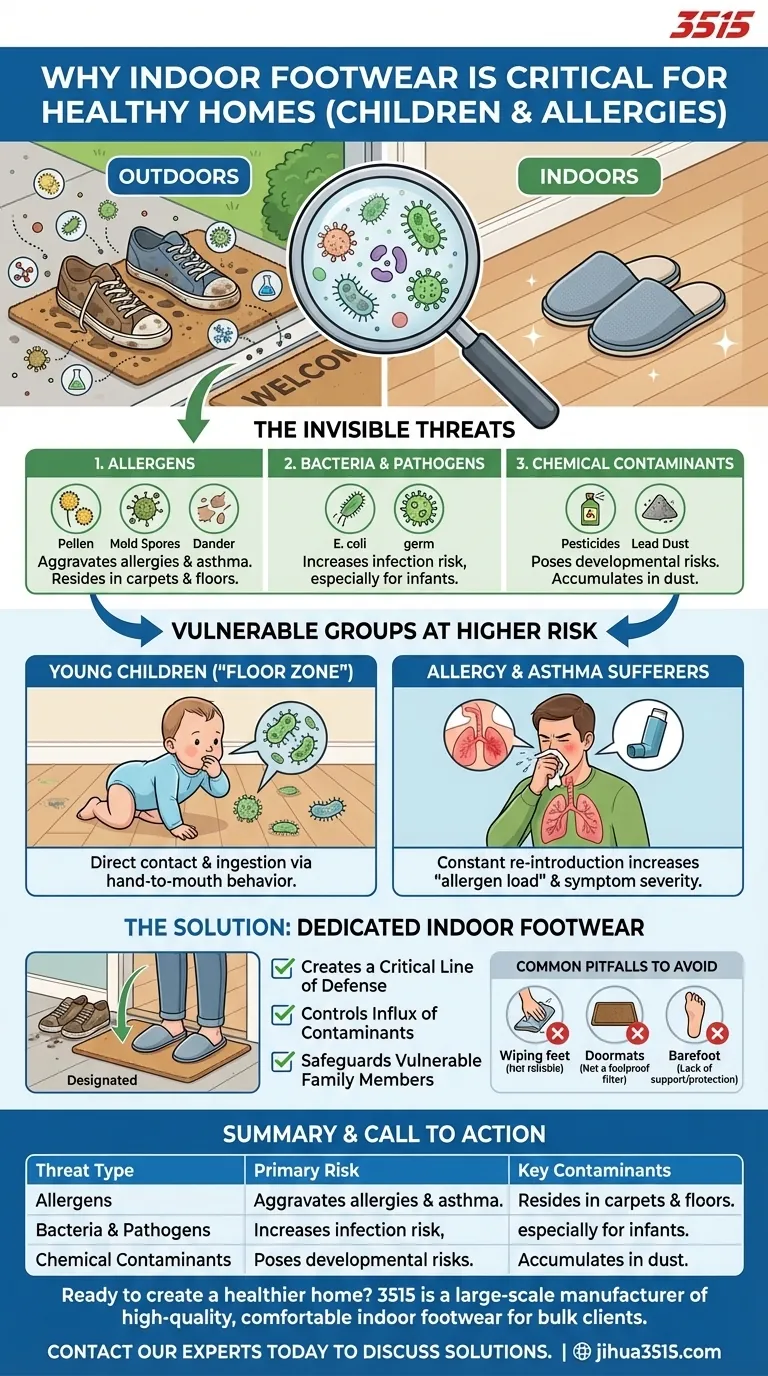Indoor footwear is particularly important because it serves as a critical line of defense for households with young children or allergy sufferers. Outdoor shoes transport pollen, bacteria, and chemical residues from the outside world directly onto your floors and carpets, creating a reservoir of potential health triggers where the most vulnerable family members live and play.
The central issue extends far beyond visible dirt; it's about the microscopic contaminants your shoes carry. Adopting a dedicated indoor shoe policy is one of the most effective ways to control the influx of allergens and pathogens, directly safeguarding the health of those most susceptible within your home.

The Invisible Threats on Your Shoes
The soles of our shoes come into contact with a vast range of substances. While most are harmless, some pose a significant risk, especially when concentrated inside a home.
Allergens from the Outdoors
Outdoor environments are filled with allergens. Shoes are highly effective at capturing and transporting pollen from trees and grasses, mold spores from damp soil, and dander from animals.
Once inside, these allergens are deposited into carpet fibers and on hard floors, becoming a constant source of irritation for anyone with respiratory sensitivities.
Bacteria and Pathogens
Public sidewalks, parks, and floors harbor a wide array of bacteria, including pathogens like E. coli.
These microorganisms are easily picked up by shoe soles and transferred into the home. This creates an unnecessary exposure risk, particularly for young children who spend their time on the floor.
Chemical Contaminants
Shoes can also track in harmful chemical residues. This includes lawn pesticides from parks, herbicides from walkways, and even lead dust from contaminated soil near older buildings.
These toxins can accumulate in household dust and on surfaces, posing a developmental risk to infants and toddlers.
Why Vulnerable Groups Are at Higher Risk
A home should be a safe haven, but contaminants tracked indoors can uniquely affect certain individuals. The world looks very different from three feet off the ground.
The "Floor Zone" for Young Children
Babies and toddlers live in the "floor zone." They crawl, play, and explore their world at ground level.
This puts them in direct contact with any contaminants deposited by outdoor shoes. Their natural hand-to-mouth behavior significantly increases the likelihood of ingesting these harmful substances.
Amplifying Allergy and Asthma Triggers
For individuals with allergies or asthma, managing the indoor environment is crucial for controlling symptoms.
When outdoor shoes continually re-introduce triggers, they increase the home's overall "allergen load." This can lead to more frequent and severe reactions, turning their sanctuary into a source of chronic exposure.
Common Pitfalls to Avoid
Simply being aware of the problem isn't enough. Many households have practices they believe are sufficient but fall short of providing true protection.
The Myth of the "Clean" Shoe
A shoe that looks clean is not necessarily safe. The most potent allergens and harmful chemical residues are microscopic and invisible to the naked eye. Wiping your feet is not a reliable method for removing them.
Doormats Are Not Enough
While a high-quality doormat can help reduce the amount of visible dirt and debris, it is not a foolproof filter. It cannot capture all microscopic particles and pathogens, which will inevitably be tracked further into the home.
Barefoot Isn't Always the Ideal Alternative
Going barefoot is certainly better than wearing outdoor shoes inside. However, dedicated indoor shoes or slippers can provide better foot support and protection, especially on hard surfaces, and help prevent the spread of foot-related issues like plantar warts.
Making the Right Choice for Your Goal
Implementing a new household rule is most effective when the purpose is clear. Your strategy should align with your primary health objective.
- If your primary focus is protecting a crawling infant: The goal is to eliminate their contact with floor-level bacteria and chemical residues like lead dust and pesticides.
- If your primary focus is reducing allergy or asthma symptoms: The goal is to stop the constant re-introduction of pollen, mold, and dander into your home's air and surfaces.
- If your primary focus is general home cleanliness: An indoor shoe policy dramatically reduces the amount of dirt tracked inside, cutting down on the frequency and intensity of floor cleaning.
By treating your doorway as a deliberate checkpoint, you actively create a cleaner, safer, and healthier sanctuary for your family to thrive in.
Summary Table:
| Threat Type | Primary Risk | Key Contaminants |
|---|---|---|
| Allergens | Aggravates allergies & asthma | Pollen, mold spores, animal dander |
| Bacteria & Pathogens | Increases infection risk, especially for infants | E. coli, other harmful bacteria |
| Chemical Contaminants | Poses developmental risks to children | Pesticides, herbicides, lead dust |
Ready to create a healthier home environment?
As a large-scale manufacturer, 3515 produces a comprehensive range of high-quality, comfortable indoor footwear for distributors, brand owners, and bulk clients. Our production capabilities encompass all types of shoes and boots designed for safety and comfort indoors.
We can help you provide the right footwear to protect vulnerable family members from invisible threats. Contact our experts today to discuss your needs and discover our solutions.
Visual Guide

Related Products
- Durable Rubber-Soled Utility Shoes for Wholesale & Custom Brand Manufacturing
- Premium Lightweight Safety Shoes for Wholesale & Bulk Orders
- Wholesale Breathable Training Shoes Custom Athletic Footwear Manufacturer
- Premium KPU Athletic Safety Shoes for Wholesale
- Wholesale Durable & Breathable Training Shoes for Custom Brands
People Also Ask
- What is vulcanized rubber and why is it used in products? The Key to Durable, Flexible Footwear
- What makes rubber sole shoes an economical and practical choice? Unmatched Durability & All-Weather Value
- What are the benefits of rubber work shoes? Unbeatable Protection for Wet & Demanding Jobs
- What are rubber soled shoes? The Ultimate Guide to Durable, All-Weather Footwear
- What are the disadvantages of leather shoe soles? Key Limitations in Traction & Durability



















